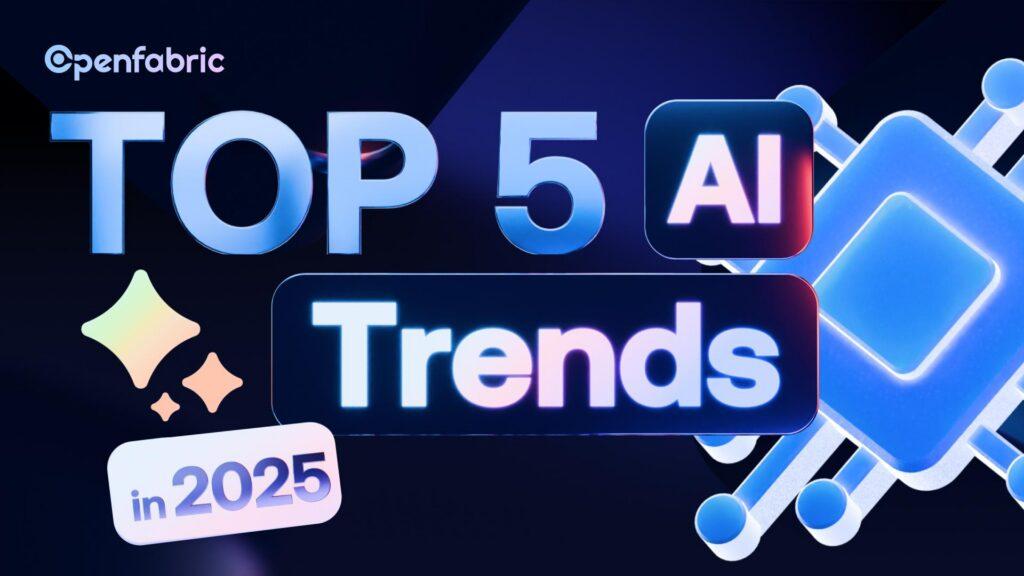
October 17, 2025 5 minutes read
Top 5 Latest AI Trends in 2025

Do you know that globally, at least 78% of organizations use artificial intelligence in at least one of their functions?
AI implementation has reached a high point across every industry. Data confirms that at least 78% in 2024 alone, a number that has since risen in 2025. This rapid adoption of AI has given rise to some latest AI trends in 2025 that every business owner must be aware of to stay ahead of the curve.
Back in 2023, some of the AI innovations we use now, such as agentic AI, had not fully materialized into the automated systems we have now. However, the current case is different as agentic AI adoption dominates the industry.
In 2025, we have seen generative AI mature into a tool that prioritizes user intent and accuracy of information over just churning out results. These systems can now plan, execute, self-correct, and even act in the physical world. What seemed like science fiction in previous years is now a reality and is being used in everyday activities.
In this blog, we will explore the latest AI trends that both business owners and tech enthusiasts should be excited about.
Let’s get started!
5 latest AI trends in 2025
Agentic AI
Agentic AI is unlike passive AI assistants or tools. This new AI innovation can initiate a goal-oriented task, plan how to execute it, execute the plan, and react adaptively. It requires minimal to no human intervention. For this reason alone, there is an improvement in AI benchmarks. In 2023, researchers introduced new AI benchmarks to test the limits of advanced AI systems. A year later, performance increased by up to 67.3%.
Key technical considerations that make agentic AI include:
- Planner and executor architectures: this handles orderly task planning and reinforcement learning.
- Tool chaining: allows agents to connect to APIs, external modules, and submodules.
- Inter-agent intercommunication protocols: allow for inter-agent communication and agent-to-agent negotiation for the allocation of resources.
Despite all these developments, agentic AI is not without its challenges and limitations. Some of these limitations include:
- Alignment between agentic AI and the dynamic human environment
- Transparency to allow users to understand why the agent made a decision
- Slow adoption due to compliance with regulatory policies
Physical AI
One of the latest AI trends we have seen in 2025 is the integration of AI into robots. This has taken AI from being just digital to being physical. Nowadays, we are seeing integrated systems that combine perception, control, and planning to interact with our immediate environment and react in real-time.
We have drones, robots, automated vehicles, and sensor-rich AI control systems that allow us to interact with AI systems. For instance, Sim2real transfer allows us to bridge the gap between simulation and the real world.
Investment trends in AI
Smart investors have identified AI as a potential jackpot, and the investments in AI have been ever-growing. According to Stanford University’s Index report, in 2023, the U.S saw up to $67.2 billion in investments in AI. Not so surprisingly, this number rose in 2024 and is expected to keep rising in the next three years. This follows a 2024 McKinsey report, which reported that up to 67% of companies plan to significantly increase their investments in AI over the next three years.
These numbers point to the belief in the long-term impact of AI. As the numbers continue to rise, governments, companies, and individuals around the world will continue to invest more and more in AI. Therefore, now is the best time to key into this opportunity.
AI adoption across sectors
The adoption of AI across various sectors is not uniform. However, a number of sectors have seen a tremendous increase in the adoption of AI. Let us see some of them:
- Healthcare: the healthcare industry has seen a large increase in the adoption of AI in diagnostics, patient management, and clinical documentation. AI has especially helped with clinical documentation as AI-powered chatbots can now handle initial patients’ inquiries and assist in directing the patient to the particular doctor they need. Innovative tools like Openfabric Radiology Assistant can now assist with reading radiographs and spotting inconsistencies, aiding in the prompt delivery of patient care.
- Sales and manufacturing: up to 77% of manufacturers now utilize AI solutions to automate manufacturing processes. This is compared to 70% in 2024. In this industry, predictive maintenance stands out as the most common use of AI tools. Here, AI tools help manufacturers anticipate equipment failure before it occurs.
AI agents have also helped manufacturers generate revenue through personalized recommendations and providing prompt responses to customer inquiries. Also, AI has been able to identify flaws or pain points that need to be addressed, thereby improving service quality. - Human Resources: companies have been able to shorten the time used for employing a candidate through AI-automated hiring processes. AI-powered hiring tools streamline recruitment processes by parsing through thousands of applications with accuracy.
The only problem with this is that if there are any biases in the AI tool, it makes the process flawed and unfair to the affected group of people. This highlights the need for reducing bias in AI. - Finance: There has been a surge in the use of AI in the finance industry, especially for fraud detection. Reports show that financial services are investing heavily in artificial intelligence, with a global annual spending of more than $20 billion in 2025. Fraud detection systems process millions of transactions per second to identify suspicious patterns and prevent fraud. Tools like Openfabric crypto trading bot help investors identify trading opportunities, keeping them always ahead in the competitive market.
Government regulations on AI
At the beginning of AI adoption, most governments around the world still had vague regulations that limited the use of AI in industries located there. However, in 2024, U.S federal agencies introduced 59 AI-related regulations, more than double that in 2023. On a global platform, there have been legislative moves towards AI, showing growing attention.
Governments are also largely investing in scaling AI solutions in their countries. For instance, in Asia, China has invested $47.5 billion in a semiconductor fund while Saudi Arabia has initiated a $100 billion initiative called Project Transcendence to make it a global leader in AI and other advanced technologies.
Conclusion
This article is not just about what to know about the AI industry now. It shows the story of the transition of AI from novelty to maturity. While challenges still exist in the industry, this upward trend shows that these challenges can be overcome, and they do not prevent us from enjoying the smart world that AI is creating.
The previous years in AI development were largely a “track-laying phase”. What we are seeing now is a “train riding phase,” and with the increase in these developments, the ride is set to get smoother and faster.

